
Sparidae is a family of ray-finned fishes belonging to the order Spariformes, the sea breams and porgies, although they were traditionally classified in the order Perciformes. They are found in shallow temperate and tropical waters around the world and are demersal carnivores.
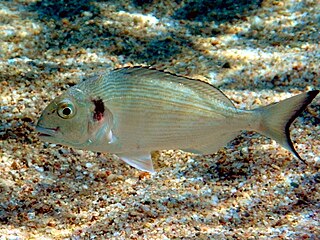
The gilt-head bream, also known as the gilthead, gilt-head seabream or silver seabream, is a species of marine ray-finned fish belonging to the family Sparidae, the seabreams or porgies. This fish is found in the Eastern Atlantic and the Mediterranean. It is a highly esteemed food fish and an important species in aquaculture.

Pagrus is a genus of marine ray-finned fishes belonging to the family Sparidae, which includes the seabreams and porgies. These fishes are found in the Western Pacific Ocean, Atlantic Ocean and Mediterranean Sea. They are esteemed food fishes which are targeted by commercial fisheries and are grown in aquaculture.

The black seabream is a species of marine ray-finned fish belonging to the family Sparidae, which includes the seabreams and porgies. This fish has a wide distribution in the eastern Atlantic Ocean and the Mediterranean and Black Seas. The black seabream is an important food fish, especially in Europe.
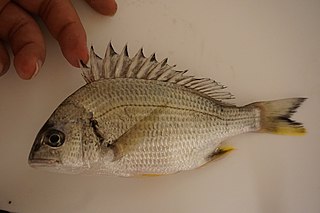
Acanthopagrus latus, the yellowfin seabream, grey bream, Houttuyn's yellowfin seabream, Japanese bream or yellow-finned black porgy, is a species of marine ray-finned fish belonging to the family Sparidae, the seabreams and porgies. This fish is found in the Western Pacific Ocean.

The spottail pinfish is an ocean-going species of fish in the family Sparidae. It is also known as the spottail seabream or spottail pinkish porgy. Along with other members of their family, spottail pinfish are occasionally eaten and considered by some to be a panfish.

The saddled seabream, also called the saddle bream or oblade, is a species of ray-finned fish belonging to the family Sparidae, which includes the seabreams and porgies. It is the only species in the monospecific genus Oblada. This species is found in the Eastern Atlantic Ocean. It is an important food fish within its range.

Diplodus sargus, the sargo, common white seabream, or white seabream is a species of marine ray-finned fish belonging to the family Sparidae, which includes the seabreams and porgies. This fish is found in the eastern Atlantic Ocean and in the Mediterranean Sea. It is a target species for commercial fisheries and is grown in aquaculture. D. sargussensu lato was formerly thought to be a widespread species in the eastern Atlantic and western Indian Oceans but the taxa outside of D, sargussensu stricto are now recognised as valid species and are part of the D. sargus species complex.

Diplodus is a genus of marine ray-finned fish belonging the family Sparidae, which includes the seabreams and porgies. These fishes are found in the Atlantic Ocean, the Mediterranean Sea and the western Indian Ocean.
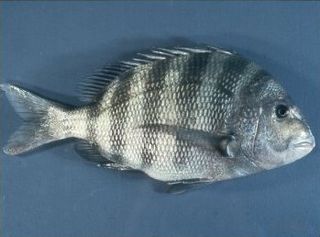
Archosargus is a genus of marine ray-finned fishes belonging to the family Sparidae, the sea breams and porgies. These fishes occur in the Western Atlantic and Eastern Pacific Oceans.

Diplodus vulgaris, the common two-banded sea bream, is a species of marine ray-finned fish belonging to the family Sparidae, which includes the seabreams and porgies. This species is found in the northeastern Atlantic Ocean and the Mediterranean. It is an important species for fisheries and is grown in aquaculture.

Acanthopagrus is a genus of marine ray-finned fishes belonging to the family Sparidae, the sea breams and porgies. The fish in this genus are found in the Indian and western Pacific Oceans.
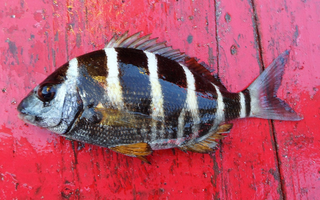
The banded seabream is a species of marine ray-finned fish belonging to the family Sparidae, which includes the seabreams and porgies. This species is endemic to Cape Verde in the eastern Atlantic Ocean.
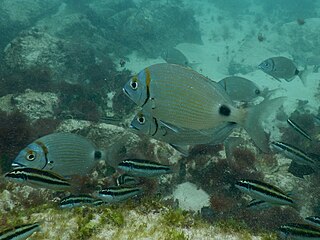
Diplodus prayensis, the two-banded seabream, is a species of marine ray-finned fish belonging to the family Sparidae, which includes the seabreams and porgies. This species is endemic to the Cape Verde Islands.
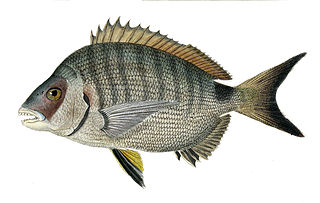
The St. Helena white seabream is a species of marine ray-finned fish belonging to the family Sparidae, which includes the seabreams and porgies. This fish is endemic to the island of Saint Helena in the southern Atlantic.

Diplodus hottentotus, the zebra, is a species of marine ray-finned fish belonging to the family Sparidae, which includes the seabreams and porgies. This fish is found in the Western Indian Ocean off Southern Africa.
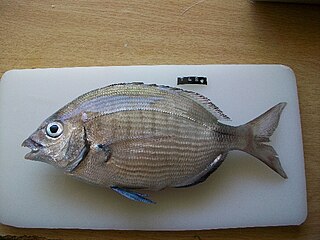
Diplodus capensis, the Cape white seabream or blacktail seabream, is a species of marine ray-finned fish belonging to the family Sparidae, which includes the seabreams and porgies. This fish is found around the coasts of Southern Africa.

Diplodus annularis, the annular seabream is a species of marine ray-finned fish belonging to the family Sparidae, the family which includes the seabreams and porgies. This species is found in the Eastern Atlantic Ocean and Mediterranean.

Pagellus acarne, the axillary seabream or Spanish seabream is a species of marine ray-finned fish belonging to the family Sparidae, which includes the seabreams and porgies. This fish is found in the eastern Atlantic Ocean and Mediterranean Sea.
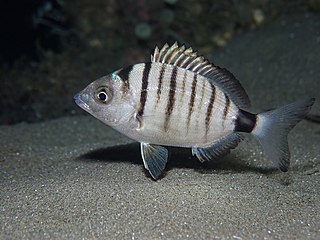
Diplodus puntazzo, the sharpsnout seabream, sheephead bream or puntazzo, is a species of marine ray-finned fish belonging to the family Sparidae, which includes the seabreams and porgies. This species is found in the, Eastern Atlantic and the Mediterranean and Black Seas. This omnivorous fish is an important species for aquaculture and fisheries, despite the flesh not being highly esteemed.




















